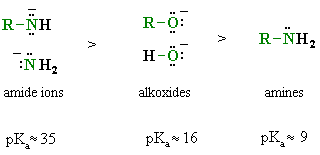Chapter 6: Acidity and Basicity |
Chapter 6: Acidity and Basicity |
Always remember that acidity and basicity are the based on the same chemical reaction (essentially looking at it from opposite sides) and both happen simultaneously.
In the following simple example the base, B, removes a proton from the acid, H-A:

QUESTION : Can you think of another type of reaction that must involve opposites simultaneously ? ANSWER
There are three theories used to describe acids and bases (see below). Note that it will be both the Bronsted and Lewis definitions that are likely to be the most useful to an organic chemist.
Acids |
Bases |
|
| Arrenhius | Ionise to give H+ in
H2O |
Ionise to give HO- in H2O |
| Bronsted-Lowry | A proton donor |
A proton acceptor |
| Lewis | An electron pair acceptor |
An electron pair donor |
Now, some terminology:

CURLY ARROWS comment.... note the direction and flow of the electrons : from the base (e donor) to the acid (the proton H+).... a common mistake is to get this backwards. Remember the curly arrows show the ELECTRON movement. Check the charges....
Protonate : means "add a proton to", i.e. react with H+, or, react with an acid, which means the species that is being protonated is the base.
Deprotonate : means "take a proton away from" i.e. remove H+, or, react with a base, which means the species that is being deprotonated is the acid.
Look at this equation and see how it fits the Bronsted-Lowry and Lewis definitions.

![]()
![]()
Equations and other terms.... pH, pKa etc.
Key factors that affect the stability of the conjugate base, A-,
| HF > H2O > NH3 > CH4 | Electronegativity. When comparing atoms within the same row of the periodic table, the more electronegative the anionic atom in the conjugate base, the better it is at accepting the negative charge. |
| HI > HBr > HCl > HF | Size. When comparing atoms within the same group of the periodic table, the easier it is for the conjugate base to accommodate negative charge (lower charge density). The size of the group also weakens the bond H-X (note this trend should be applied with care since it only works within a group). |
| RCO2H > ROH | Resonance. In the carboxylate ion, RCO2- the negative charge is delocalised across 2 electronegative oxygen atoms which makes it more stable than being localised on a specific atom as in the alkoxide, RO-. |
General acidity trend of common organic acids (this is a very useful sequence to remember and to be able to rationalise):

Basicity
A convenient way to look at basicity is based on electron pair availability....
the more available the electrons, the more readily they can be donated to form
a new bond to the proton and, and therefore the stronger base.
Key factors that affect electron pair availability in a base, B
| CH3- > NH2- > HO- > F- | Electronegativity. When comparing atoms within the same row of the periodic table, the more electronegative the atom donating the electrons is, the less willing it is to share those electrons with a proton, so the weaker the base. |
| F- > Cl- > Br- > I- | Size. When comparing atoms within the same group of the periodic table, the larger the atom the weaker the H-X bond and the lower the electron density making it a weaker base. |
| RO- > RCO2- | Resonance. In the carboxylate ion, RCO2- the negative charge is delocalised across 2 electronegative atoms which makes it the electrons less available than when they localised on a specific atom as in the alkoxide, RO-. |
General acidity trend of some common organic bases:
Note that organic chemists tend to think about bases by looking at the pKa's of their conjugate acids, i.e. think about B- by looking at the acidity of BH. The implications are that the higher the pKa of the related conjugate acid, BH, the stronger the baseb B-.

AND Therefore, both are affected by the same factors, just in opposite ways. |
 |
© Dr. Ian Hunt, Department of Chemistry |